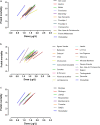First national-scale evaluation of temephos resistance in Aedes aegypti in Peru
- PMID: 35818063
- PMCID: PMC9397858
- DOI: 10.1186/s13071-022-05310-x
First national-scale evaluation of temephos resistance in Aedes aegypti in Peru
Abstract
Background: The development of resistance against insecticides in Aedes aegypti can lead to operational failures in control programs. Knowledge of the spatial and temporal trends of this resistance is needed to drive effective monitoring campaigns, which in turn provide data on which vector control decision-making should be based.
Methods: Third-stage larvae (L3) from the F1 and F2 generations of 39 Peruvian field populations of Ae. aegypti mosquitoes from established laboratory colonies were evaluated for resistance against the organophosphate insecticide temephos. The 39 populations were originally established from eggs collected in the field with ovitraps in eight departments of Peru during 2018 and 2019. Dose-response bioassays, at 11 concentrations of the insecticide, were performed following WHO recommendations.
Results: Of the 39 field populations of Ae. aegypti tested for resistance to temephos , 11 showed high levels of resistance (resistance ratio [RR] > 10), 16 showed moderate levels of resistance (defined as RR values between 5 and 10) and only 12 were susceptible (RR < 5). The results segregated the study populations into two geographic groups. Most of the populations in the first geographic group, the coastal region, were resistant to temephos, with three populations (AG, CR and LO) showing RR values > 20 (AG 21.5, CR 23.1, LO 39.4). The populations in the second geographic group, the Amazon jungle and the high jungle, showed moderate levels of resistance, with values ranging between 5.1 (JN) and 7.1 (PU). The exception in this geographic group was the population from PM, which showed a RR value of 28.8 to this insecticide.
Conclusions: The results of this study demonstrate that Ae. aegypti populations in Peru present different resistance intensities to temephos, 3 years after temephos use was discontinued. Resistance to this larvicide should continue to be monitored because it is possible that resistance to temephos could decrease in the absence of routine selection pressures.
Keywords: Aedes aegypti; Arboviruses; Insecticide resistance; Resistance ratio (RR); Temephos; Vector control.
© 2022. The Author(s).
Figures



Similar articles
-
Levels of insecticide resistance to deltamethrin, malathion, and temephos, and associated mechanisms in Aedes aegypti mosquitoes from the Guadeloupe and Saint Martin islands (French West Indies).Infect Dis Poverty. 2017 Feb 10;6(1):38. doi: 10.1186/s40249-017-0254-x. Infect Dis Poverty. 2017. PMID: 28187780 Free PMC article.
-
Alternative insecticides for larval control of the dengue vector Aedes aegypti in Lao PDR: insecticide resistance and semi-field trial study.Parasit Vectors. 2018 Dec 3;11(1):616. doi: 10.1186/s13071-018-3187-8. Parasit Vectors. 2018. PMID: 30509299 Free PMC article.
-
Differential transcription profiles in Aedes aegypti detoxification genes after temephos selection.Insect Mol Biol. 2014 Apr;23(2):199-215. doi: 10.1111/imb.12073. Epub 2013 Dec 3. Insect Mol Biol. 2014. PMID: 24299217 Free PMC article.
-
Change in susceptibility response of Aedes aegypti (Diptera: Culicidae) to organophosphate insecticide and Copaifera oleoresin.Acta Trop. 2021 Sep;221:106014. doi: 10.1016/j.actatropica.2021.106014. Epub 2021 Jun 17. Acta Trop. 2021. PMID: 34146537
-
Variation in temephos resistance in field populations of Aedes aegypti (Diptera: Culicidae) in the State of Sergipe, Northeast Brazil.Rev Soc Bras Med Trop. 2018 May-Jun;51(3):284-290. doi: 10.1590/0037-8682-0449-2017. Rev Soc Bras Med Trop. 2018. PMID: 29972557
Cited by
-
Spent Coffee Grounds and Novaluron Are Toxic to Aedes aegypti (Diptera: Culicidae) Larvae.Insects. 2023 Jun 16;14(6):564. doi: 10.3390/insects14060564. Insects. 2023. PMID: 37367380 Free PMC article.
-
Widespread Resistance to Temephos in Aedes aegypti (Diptera: Culicidae) from Mexico.Insects. 2024 Feb 7;15(2):120. doi: 10.3390/insects15020120. Insects. 2024. PMID: 38392539 Free PMC article.
-
Insecticide Resistance Status of Aedes aegypti Adults and Larvae in Nouakchott, Mauritania.Insects. 2025 Mar 11;16(3):288. doi: 10.3390/insects16030288. Insects. 2025. PMID: 40266825 Free PMC article.
-
Encapsulation of Beauveria bassiana conidia as a new strategy for the biological control of Aedes aegypti larvae.Sci Rep. 2024 Dec 30;14(1):31894. doi: 10.1038/s41598-024-83036-9. Sci Rep. 2024. PMID: 39738305 Free PMC article.
-
Laboratory Evaluation and Field Feasibility of Micro-Encapsulated Insecticide Effect on Rhodnius prolixus and Triatoma dimidiata Mortality in Rural Households in Boyacá, Colombia.Insects. 2022 Nov 17;13(11):1061. doi: 10.3390/insects13111061. Insects. 2022. PMID: 36421964 Free PMC article.
References
-
- Castillo-Quino R, Vallejo-Castro E, Camacho-Aliaga AV, Canelas-Urey HI. Adaptación del mosquito Aedes aegypti a 2 550 m s.n.m. Cochabamba, Bolivia, Febrero 2016. Gac Medica Boliv. 2018;41(1):24–30. doi: 10.47993/gmb.v41i1.148. - DOI
-
- Ruiz-López F, González-Mazo A, Vélez-Mira A, Gómez GF, Zuleta L, Uribe S, et al. Presencia de Aedes (Stegomyia) aegypti (Linnaeus, 1762) y su infección natural con el virus del dengue en alturas no registradas para Colombia. Biomedica. 2016;36(2):303–308. doi: 10.7705/biomedica.v36i2.3301. - DOI - PubMed
MeSH terms
Substances
LinkOut - more resources
Full Text Sources
Miscellaneous

